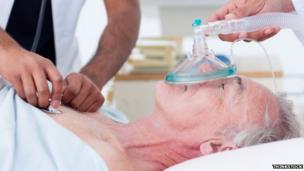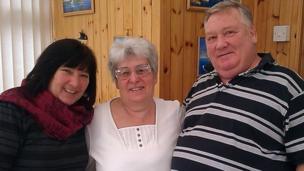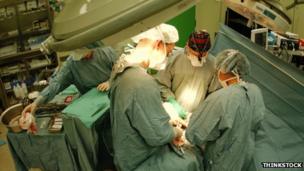A doctor says people can be revived several hours after they have seemingly died. Should this change the way we think about death?
Carol Brothers can't recall the exact moment she died.
"I know it must have been a Friday around lunchtime, because we'd got back from shopping," the 63-year old says. "I can't remember getting out of the car."
Her husband David has much clearer memories of that day three months ago. He opened the front door of their Wiltshire home and saw Carol lying down, gasping for breath, the colour rapidly draining from her face.
Carol had had a cardiac arrest - her heart had stopped beating. Luckily, an elderly neighbour knew the rudiments of cardiopulmonary resuscitation (CPR) and quickly began to work on her chest.
Paramedics soon took over, and at a point between 30 and 45 minutes after her collapse - no-one noted the exact time - Carol's heart started beating again.
"While 45 minutes is absolutely remarkable and a lot of people would have written her off, we now know there are people who have been brought back, three, four, five hours after they've died and have led remarkably good quality lives," says Dr Sam Parnia, the director of resuscitation research at Stony Brook University in New York.
Most people regard cardiac arrest as synonymous with death, he says. But it is not a final threshold.
Doctors have long believed that if someone is without a heartbeat for longer than about 20 minutes, the brain usually suffers irreparable damage. But this can be avoided, Parnia says, with good quality CPR and careful post-resuscitation care.
He says it is vital that chest compressions occur at the right rate and force and that patients are not over-ventilated. CPR would be considerably prolonged, with machines doing the work.
Doctors also have new ways to care for patients after their hearts have been restarted.
As Parnia explains in his new book the Lazarus Effect (the US title is Erasing Death), after the brain stops receiving a regular supply of oxygen through the circulation of blood it does not instantly perish but goes into a sort of hibernation, a way of fending off its own process of decay.
The process of "waking up" this hibernated brain may well be the riskiest time of all, since oxygen can potentially be toxic at this stage.
The effect, Parnia says, is like that of a tsunami following an earthquake, and the best response is to cool patients down, from 37C to 32C.
"Cooling therapy, the reason it works so well, is that it actually slows down brain cell decay," says Parnia.
This is where Carol Brothers was again in luck.
After her heart was restarted, she was put on a helicopter where a doctor cooled her down using the frozen food she had just bought at the supermarket.
She was ultimately put in the care of Dr Jerry Nolan, an intensive care consultant at Bath's Royal United Hospital. This was yet more luck - Nolan co-wrote best practice guidelines for the UK Resuscitation Council, which he chairs.
By this time, Carol was in a coma. As the next few days passed, none of the signs were good - seizures and ominous EEG scans indicated that she might be brain dead. It looked like she had survived the earthquake but been left devastated by the tsunami.
On the Monday following Carol's collapse, Nolan advised David and his daughter Maxine that the kindest thing might be to allow Carol to die. They agreed.
But when Maxine visited the hospital again three days later she found her mother awake and looking around.
"She said three little words to me," recalls Maxine. "She said: 'I'm coming home.' It was a little tiny faint whisper."
Cooling therapy is changing everything. Whereas Carol's seizures and low brain activity would once have been seen as unambiguously bad signs, such symptoms may be compatible with a good recovery.
"We're much more uncertain than we thought we were," says Nolan, adding that research groups across the world were urgently looking at cases like Carol's to draw up new guidelines.
Parnia says the guidelines already in circulation are not routinely enforced by hospitals.
"Carol was very lucky that she ended up in a hospital with such an eminent expert," he says. "In the US and the UK there is absolutely zero regulation regarding the quality of care that somebody like Carol should receive."
Nolan stops short of saying that Carol was brought back from the dead. Hospitals do not declare death, he says, until they have ruled out all processes that can be reversed. However, he agrees with Parnia that our concept of death needs updating.
"We used to think death was a sort of sudden event - we stop the oxygen going to the brain and after a few minutes that was that. But actually, we know that the dying process at the cellular level goes on for a period of time."
The increasingly blurred line between life and death is prompting metaphysical questions as well as medical ones.
Parnia has become fascinated by patients' accounts of being "near death", which he says about 10% of survivors have.
"People from all over the world in essence describe the same universal experience, but the interpretation of what they see depends on their own belief system," he says.
These descriptions include travelling down tunnels towards bright lights, meeting angelic figures, recalling past events and in rare cases, floating above the surgeons in the operating theatre.
Parnia is currently working with a number of hospitals on a project to investigate out of body experiences. One of the components of the study is to place objects on high shelves in operating theatres, which are only observable from above.
Caroline Watt is a psychologist at the University of Edinburgh who specialises in examining paranormal accounts with an open but critical mind. She was the co-author of a review paper suggesting that near-death experiences may well be based in neurological activity.
She says one study found about half the patients that reported near-death experiences had not been anywhere near death at all. They had experienced them at times when they were expecting a traumatic experience, such as during childbirth. This perhaps suggests that whatever the sensation is, it isn't a glimpse of the afterlife.
Ruth Lambert suffered a near-death experience when a fall led to the blood supply to her brain being cut off.
"It was a sense of welcome and going to something better," she recalls. "I had a strong sense of being addressed by God directly, that this was not the right time for me and then I woke up."
Since that time, partly through her work as a senior chaplain at an NHS hospital in London, she has been approached several times with similar accounts.
She remembers one man who came round from his coma terrified - he believed he had seen the Devil approaching him and saying: "You're mine now - I've got you."
She adds that most religious people see death as a "final gateway" and that any evolution of this concept will be very significant for them.
If Carol Brothers met God or the Devil, she doesn't remember it now.
"Neither of them wanted me," she says. "They flipped the coin and it landed on its edge."



No comments:
Post a Comment